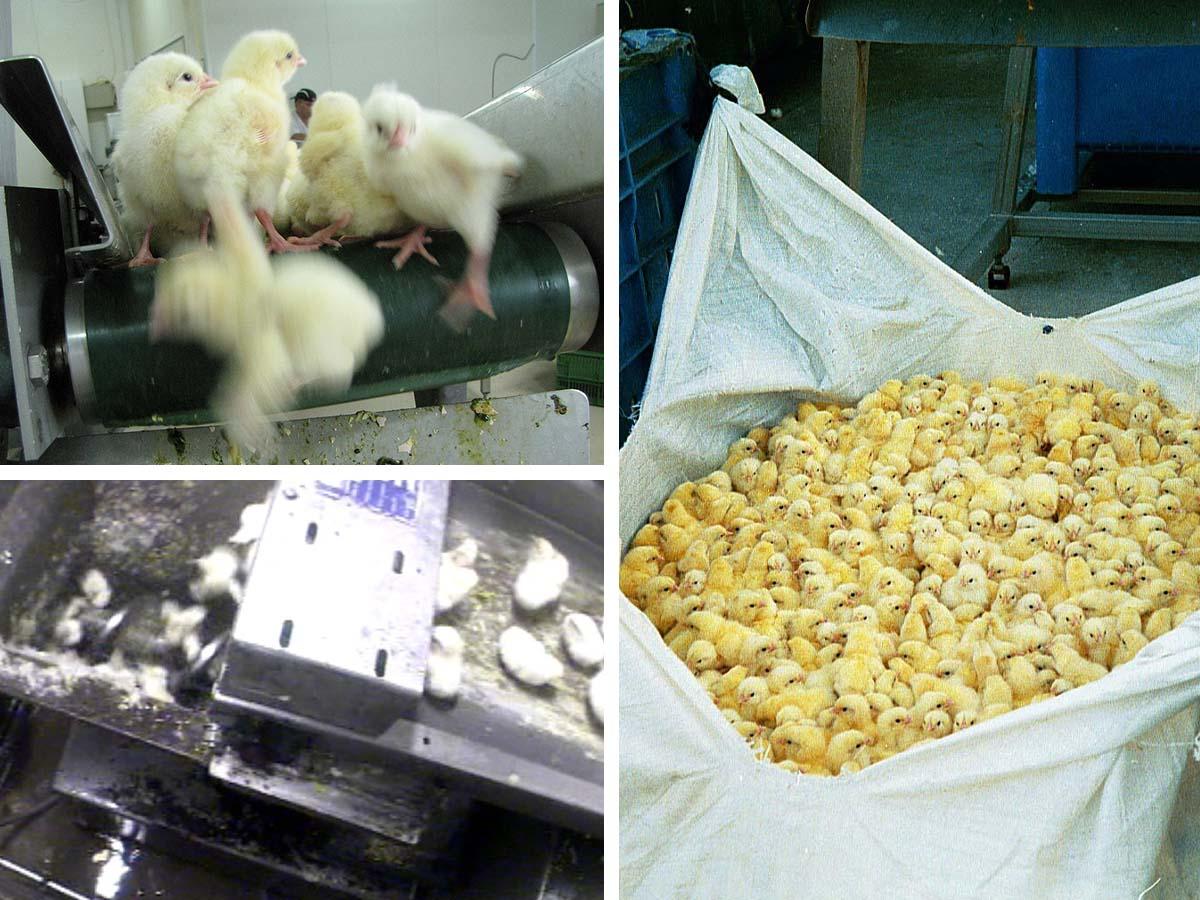Chick Grinding: the Hidden Horror of Egg Production
Every year in egg-producing factories, billions of newborn male chicks are ground up alive in meat grinders. It's hard to fathom any more gruesome death than being macerated into pieces by relentlessly churning steel blades. At just one day old, before they can barely make a peep, these chicks are shredded and thrown away like trash in the most torturous way possible. Why does this happen? The simple but callous answer is that male chicks are useless to egg producers, an added cost with no benefit.
Males can't lay eggs like mother hens, who suffer their own form of torture by being debeaked and stuffed into cages or crammed into cavernous dank warehouses. And since they are a different breed of chicken than those used for meat, these male chicks have no other way to generate profit for egg producers. The alternative method of slaughtering chicks is gassing them or suffocating them in giant plastic bags. Despite protests by In Defense of Animals and other animal rights organizations, the atrocity of chick killing has been going on for decades in the U.S., Europe, and around the world.
However, kinder solutions are available. Several companies have invented ways to preselect male eggs, so they are not allowed to be hatched, saving on the wanton killing of innocent chicks. Germany and France are taking advantage of these innovations. Germany has banned all chick killing as of January 2022 and France’s ban will go into effect in 2023. Germany is utilizing a method called Seleggt, created by a company called respeggt GmbH, to perform ovo sexing, which extracts fluids with a laser to test for specific hormones.
This method has come under fire by some egg industry officials in the U.S. who say the tiny hole the laser creates runs the risk of contamination. European developers, however, push back on that argument and their kill-free eggs are now sold in thousands of supermarkets in Germany, the Netherlands, Switzerland, and France. The other big obstacle is cost. The fear is this kill-free method will drive up consumer costs beyond feasibility. But so far in Europe, it's proven to be cost-effective, with only modest added costs to consumers and hatcheries.
Another controversy is at what point the eggs are tested. If too late in the incubation period, the test could cause pain and suffering to the unborn chick. The Seleggt method however sorts chicks on the ninth day of development when it is purported to be highly unlikely that the embryos experience any sensations at all. Beyond the cruelty argument, killing billions of chicks every year is akin to throwing out half your product into the trash, not a very economical way to run a business.
In the U.S., little progress has been made to develop new methods to avoid chick killing. On March 15, 2021, Popular Science reported that United Egg Producers, which produce more than 90% of all commercial eggs in the U.S., made a pledge in 2016 to end chick killing by 2020. On March 25, 2021, United Egg Producers updated its statement to effectively say that the pledge cannot be met at this time. Chad Gregory, President and CEO, said, “We remain hopeful a breakthrough is on the horizon. We will continue our engagement with stakeholders and active support of this goal.”
The major blocks to implementation stated are the fear of contamination and the hiking up of costs that egg producers worry too many consumers would be unwilling to pay. United Egg Producers is working with the Foundation for Food & Agriculture Research (FFAR), which launched the “Egg-Tech Prize”—a public-private research initiative that provides funding for scientists and startups seeking to develop in-ovo sexing technologies. Using these methods could also turn the male eggs into another profitable venture by repurposing them for food, animal feed, or vaccine development. But progress in implementing any new methods is incremental and likely not going to be achieved any time soon.
In light of this glacial rate of change in U.S. egg production, and the inherent suffering of billions of chicks and also of course of the laying hens involved (which will persist even with a ban on the most egregious cruelty), it’s nice to know there are alternatives to eggs. Here are a few suggestions to get you started on egg-free cooking:
Make a tasty breakfast with Just Egg, a plant-based egg product that gets rave reviews. You can also replace eggs in cooking with a variety of ingredients. Instead of whisking in eggs, try one or more of these tried and true options:
- Chia seeds
- Flax meal(for both chia and flax, for every egg you want to replace, simply mix 1 tablespoon with 3 tablespoons of hot water and let sit for 5-10 minutes.)
- Applesauce
- Bananas
- Aquafaba (liquid from garbanzo beans)
- Silken Tofu
- Arrowroot powder
So go ahead, whip up a yummy omelet or scramble with Just Egg or enjoy your favorite baked goods by replacing eggs with these ingredients. They are all delicious ways to eat cruelty- free! You can also download our free guide to eating vegan here.


